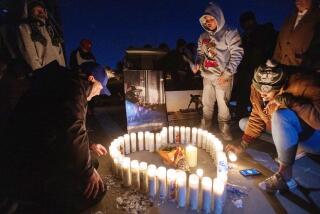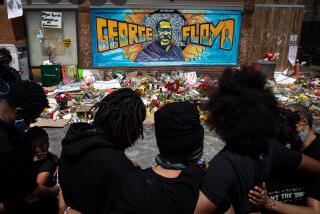George Floyd’s Houston memorial reminds friends what they survived

HOUSTON — The new mural of George Floyd across from the public housing project where he grew up reads, “Texas made, Third Ward raised,” and to longtime friend Van Dickerson, that was a badge of honor.
“For him to walk out the door, he was facing temptations every day. It was just: When will it catch up with you?” Dickerson said as he walked past the mural for the first time Sunday, ahead of Floyd’s Houston “homegoing service.”
Dickerson, 48, like Floyd, grew up trying to escape the low-income, historically black Third Ward. As friends, former classmates and teammates in Houston prepared for Floyd’s third and final funeral Tuesday, they reflected on how little has changed in the old neighborhood; how they made it out and he almost did.

As boys, Dickerson said theirs was an all-or-nothing dream: Make it to the NBA and NFL, or end up in prison or dead. It wasn’t unrealistic. The low-slung red brick housing project, Cuney Homes, known as “The Bricks” and nearby Yates Senior High School had produced their share of pro ballplayers. Floyd, at 6-feet, 6 inches, was one of many promising prospects, playing varsity basketball (forward) and football (tight end) starting freshman year, Dickerson said.
Like many in the neighborhood, they were both raised by single mothers who didn’t have much money. They relied on coaches and guys in the neighborhood, Dickerson said, who gave them cash to buy supplies like sneakers as an investment in “the one hero from the ghetto.”
“They knew we had potential to get out,” said his younger brother, Vaughn Dickerson, 45, Floyd’s former classmate and teammate.
Floyd would often give the cash to his mother to feed his five siblings.
At school, Floyd was a “rankster,” always cracking jokes and making classmates laugh, sometimes even teachers, the Dickersons said. They’d all skip class and hang out at each other’s houses. He didn’t get good enough grades to attend a top flight school but was hoping to get a scholarship somewhere out of state where he could play ball competitively.

Just before the start of Van Dickerson’s senior year, he was attending a neighborhood house party with classmate, the top-ranked player in the state, when the two were shot. Dickerson was wounded. His classmate was killed. Neighbors held a massive funeral.
“They passed the torch to Floyd – he was the next savior to come out of Cuney Homes,” Dickerson said.
Standing in front of Floyd’s mural Sunday, Dickerson stopped to greet a tired-looking man in worn clothes who he hadn’t seen in years – his dead classmate’s older brother.
“His brother was one of the greatest to come through these projects. He was their greatest hope,” Dickerson said. “You see what happens when the hope leaves the family?”
Floyd graduated with a basketball scholarship to South Florida Community College but didn’t last, mainly because he didn’t have much money and worried about his mother making ends meet at home with a part-time job at a hamburger stand, friends said. He transferred to a college closer to home, then dropped out.
Dickerson’s younger brother did the same thing but managed to graduate. So did he. But they all ended up back in the neighborhood where they grew up.
Their new goal: “Find a job by any means necessary to help your mother,” Vaughn Dickerson said.
They were not going to go pro, but there was another way they could still make big money in Third Ward, he said: drugs.
In the years that followed, they became the guys they had seen on the corners growing up, gift-givers seemingly flush with cash, boosting the projects’ next great hope. Floyd had a son and a daughter. He and his friends frequented parties DJ’d by Michael Price, a forerunner of DJ Screw, whose chop ‘n’ screw hip-hop style would later become famous. “Big Floyd” even had a cameo on a DJ Screw mix tape.
“He spent more time away from the family than at home,” Van Dickerson recalled. “They never saw any wrongdoing he did – he did that with us.”
Both men ended up in prison after being convicted of armed robbery.
“As young men growing up in poverty, we all done missed the mark. There was a generational curse on the ghetto, said Vaughn Dickerson, who also has a felony record, noting many of his friends did time, “And when you got home, the hood still embraced you.”
Floyd served four years, and like the Dickersons, emerged a changed man, determined to leave Third Ward and start a new life.

Floyd’s classmate Mary Ginns, 45, a hairstylist, said he wrote to her from prison, reassuring her that he was OK, and that after he was released “he didn’t get in trouble anymore.”
“He was telling everybody he was going to change the world,” she said.
Vaughn Dickerson remembered seeing Floyd after he was released from prison, walking through the neighborhood in dress slacks, a button-down shirt and tie on his way to a job interview. Dickerson offered him some cash and a ride. Floyd declined.
“He said, ‘I’ve got to do this on my own. I’ve got to stay on this path.’ So he learned from his experience,” Dickerson said.
Floyd met a new girlfriend, had a daughter and got involved with a local church that held services on the Cuney Homes basketball court, known as “Church at the Bricks.” In a video Floyd posted on social media at the time, he alluded to his record and pleaded for an end to gun violence in his neighborhood.
“I’ve got my shortcomings and my flaws, but these shootings that’s been going on — I don’t care what hood you’re from, where you’re at, man, I love you and God love you. Put the gun down,” he said.
Ultimately, Floyd decided to follow friends to a drug rehab program called Turning Point in Minneapolis. He knew a half-dozen guys who had completed the program, found work, married and bought homes. So three years ago, he moved, entered the program, started working as a bouncer and at a local Salvation Army so he could send money home. In his spare time, he was training to drive trucks.
Vaughn Dickerson spoke to Floyd before he left for Minneapolis.
“He told me he was going to get himself straight,” he said. “To him it was a given: If I get here, I’m going to be all right.”
He talked to him by phone a few times in Minnesota and said he seemed fine.
“He made a mistake, but he came out and he was changing his life,” Van Dickerson said. “… He knew being around the same friends, they’re still in the same place doing the same thing. Some have been selling drugs all their life. A lot of them have been to the penitentiary… He wanted a better way out.”
Two years ago, Floyd’s mother died and he returned to Third Ward for the funeral, but only briefly. The Dickersons figured he was afraid of backsliding.
The last time Van Dickerson talked to Floyd on the phone before the pandemic, he sounded happy, same deep voice and joking fast talk as always. He promised to visit Houston soon.
Instead, his body arrived in a gold-plated casket Monday, at the church in southwest Houston where he will be eulogized by the Rev. Al Sharpton. Former Vice President Joe Biden met with Floyd’s family Monday, as did Texas Gov. Greg Abbott, who wore a crimson and gold tie in honor of Floyd’s alma mater, Yates High. Boxer Floyd Mayweather is footing the funeral bill and is also expected to attend the funeral along with other celebrities, the mayor, members of Congress and Floyd’s extended family, including his 6-year-old daughter, Gianna.
The Dickersons also planned to attend. Van Dickerson lived to see his two daughters graduate from high school, one from his and Floyd’s alma mater, Yates, which was hosting a candlelight vigil in his honor late Monday. The eldest graduated from Texas State; the youngest was just admitted to the University of Texas at Austin. He and his brother own construction companies; Van Dickerson also owns a pharmacy and club in Third Ward. They moved to the suburb of Pearland, where Floyd will be buried Tuesday beside his mother.
Van Dickerson thinks he could just as easily be the one inside the casket.
“I feel like we were just the blessed ones,” he said. “Every year it’s just another George Floyd.”
Standing in front of Floyd’s image painted on the side of a corner store, the brothers wondered how long it would last: The mural, but also the national protests and international attention.
“Who ever would have thought a young kid from Third Ward, Cuney Homes, would change the world?” Vaughn Dickerson said.
Not much has changed in Floyd’s corner of Third Ward, which is slowly gentrifying, the Dickersons said. The house where Floyd grew up next to the projects is derelict, its windows boarded up. Nearly 69% of neighbors live below the poverty line, 28% qualify for food stamps, their median income less than $20,000, one of the city’s poorest neighborhoods. Yates High School received a D rating from the state last year.
At the mural, the Dickersons noticed Cuney Homes residents rolling dice, drinking and smoking marijuana in the afternoon heat within view of police. The brothers greeted old friends who had also moved away, sent their children to suburban schools but returned to teach them neighborhood history.
They wondered what Floyd would think of the spectacle.
“He would be for the protests but also stress let’s help the hood,” Vaughn Dickerson said. “Don’t forget us. Because he knows we’re still the bottom of the barrel. Third Ward’s still the ghetto. And nobody really, really knows the plight.”
More to Read
Sign up for Essential California
The most important California stories and recommendations in your inbox every morning.
You may occasionally receive promotional content from the Los Angeles Times.











